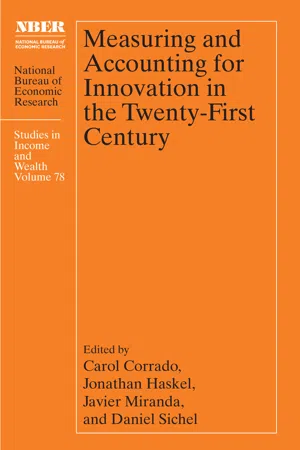![]()
IV
Improving Current Measurement Frameworks
![]()
10
Factor Incomes in Global Value Chains
The Role of Intangibles
Wen Chen, Bart Los, and Marcel P. Timmer
10.1 Introduction
The long-run decline in the income share of labor in GDP since the 1980s is one of the most debated macroeconomic trends in recent years. Various studies have documented that the trend is widely shared across industries and countries. While it has been particularly strong in the United States, it has also been observed for other advanced countries and, perhaps surprisingly, also for various emerging and poor countries.1 Recent research zooms in on potential drivers. Barkai (2017) and Karabarbounis and Neiman (2018) document a large increase in so-called factorless income in the United States: a residual that remains after subtracting payments to labor and cost of capital from GDP. Karabarbounis and Neiman (2018) argue that it can be alternatively interpreted as economic profits arising from firms’ pricing power, as income that accrues to forms of capital that are unmeasured in current national accounts statistics, or as a wedge between imputed rental rates for assets and the rate that firms perceive when making the investment. They argue that it is likely a combination of the three, concluding that the latter is most promising in explaining long-term trends in US GDP income shares.
So far, the discussion on factor incomes has been about shares in GDP of single countries. This chapter argues for the need for a multicountry approach in better understanding the drivers of increasing “factorless income.” In today’s world, goods are typically produced and distributed in intricate networks with multiple stages of production and extensive shipping of intermediate goods, services, and information. We refer to this as global value chain (GVC) production.2 So-called factoryless goods producers like Apple provide an iconic example: they sell and organize the production of manufacturing goods without being engaged in the actual fabrication process (Bernard and Fort 2015; Fontagné and Harrison 2017). They capture a major part of the value as compensation for provision of software and designs, market knowledge, intellectual property, systems integration, and cost management, as well as a strong brand name. These assets are key in the coordination of the GVC and in the creation of value. Yet we have no way to directly infer the income that accrues to these “intangibles” due to their nonphysical nature such that their use cannot be attributed to a geographic location. In contrast, tangible assets (such as machinery) and labor have a physical presence, and their use is recorded in the national account statistics of the countries where they are located. A further complication is the fact that GVC production opens up the possibility for profit-shifting of multinational enterprises across countries.3 More generally, increased cross-border sharing of intangibles is undermining the very notion of country-level factor incomes and GDP. This problem of income attribution is not new and has been discussed in the context of the system of national accounts for quite some time. The 26 percent jump in Irish GDP in 2015 also brought this “statistical problem” to public light and scrutiny.4 Guvenen et al. (2017) find that US multinationals have increasingly shifted income from intellectual property rights to foreign jurisdictions with lower taxes, suggesting an understatement of the labor share decline in US GDP.
The presence of GVC production suggests that there is a need to complement conventional factor income studies (at the country-industry level) by study of global value chains (that cross borders). Factor income analysis in GVCs will not be affected by the attribution problem and offers a unique opportunity to track the payments to intangible assets. This chapter is the first to provide such a study at the macroeconomic level.5 To fix ideas, consider a firm selling shoes using local labor L and tangible capital K. This requires two activities: fabrication and marketing. Both activities require firm-specific knowledge B (e.g., market intelligence on consumers’ preferences for particular types of shoes). Next suppose the fabrication stage is offshored to country 2. In this case the (vertically integrated) production function is Y = F(K1, L1, K2, L2, B). To infer payments to B, we calculate residual profits in the chain as the sales of a good minus the payments to tangible factor inputs needed in any stage of production:
rB = pY – ΣnwnLn – ΣnrnKn,
with wn the wage rate and rn the rental rate of tangible capital used in country n. pY is the output value of the final good. rB is measured as the residual after subtracting the sum of payments to labor L and to tangibles K across all countries involved in production. We will refer to this residual as payment for intangible assets in the GVC.
It should be noted that, given the residual approach, we measure the combined income to all intangible assets used in a chain and do not attempt to measure the stock of intangibles and their rates of return separately. In their seminal work, Corrado, Hulten, and Sichel (2005, 2009) showed how stock estimates for certain types of intangibles that are currently not treated as investment in the national accounts (such as market research, advertising, training, and organizational capital) could be derived. This requires data on intangibles’ investments as well as additional information on their depreciation rates and asset prices. Corrado et al. (2013) provide an updated analysis expanding measuremen...
